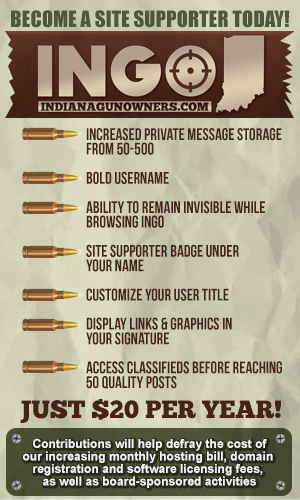-
Be sure to read this post! Beware of scammers. https://www.indianagunowners.com/threads/classifieds-new-online-payment-guidelines-rules-paypal-venmo-zelle-etc.511734/
You are using an out of date browser. It may not display this or other websites correctly.
You should upgrade or use an alternative browser.
You should upgrade or use an alternative browser.
XM designation for 5.56 ammo
- Thread starter car06281
- Start date
The #1 community for Gun Owners in Indiana
Member Benefits:
Fewer Ads! Discuss all aspects of firearm ownership Discuss anti-gun legislation Buy, sell, and trade in the classified section Chat with Local gun shops, ranges, trainers & other businesses Discover free outdoor shooting areas View up to date on firearm-related events Share photos & video with other members ...and so much more!
Member Benefits:
Does anyone know what XM means with respect to 5.56 ammo. I saw a posting on another site that suggested it is not as accurate and the military is not using it.
Have heard many "rumors" on what the XM designation stands for. Only thing I know for sure is both the 55 ( M193 ) & 62 ( M855 ) grain versions work great for me. If you have any " short stroking" issues with especially the 55 gr, you have a problem with your weapon. That stuff runs pretty hot !

shooter521
Certified Glock Nut
Federal has stated that the "XM" ammo is first-run quality, but several sources I trust dispute this, claiming as you state that it has been rejected for one reason or another.
I personally don't know what to believe, but based on the QC issues that have been cropping up with the XM193 and XM855 recently, I wouldn't buy/shoot it in any case.
My
I personally don't know what to believe, but based on the QC issues that have been cropping up with the XM193 and XM855 recently, I wouldn't buy/shoot it in any case.
My

ATK's response to this question, courtesy of The Gun Zone.
shooter521
Certified Glock Nut
ATK's response to this question, courtesy of The Gun Zone.
This begs a couple comments/questions:
1) If the "XM" ammo really is rejected lots, Federal must have some some serious QC issues going on; there's a metric buttload of it on the market right now.

2) Why are we seeing so much XM193, when M193 is not the current US military issued ammo, and hasn't been for many years now? Sure, there are probably some old 1x12 twist M-16A1s left in Guard/Reserve/AF units that would use the stuff, but that number has got to be statistically insignificant compared to the number of 1x7 twist M-16A2/A4/M4s using M855.
Adding to the confusion is the variety of packaging types in which the "XM" ammo can be encountered (bulk/Lake City, bulk/Federal, bulk/Fed American Eagle, boxed/Fed American Eagle, boxed/Fed Tactical, etc), and the attendant part number/suffix combinations (XM193A/C, XM193PD, XM193BK, etc).
Finally, the information on TGZ conflicts with what has been published on Federal's website:
XM193 product is first run, first quality product manufactured at Lake City Army Ammunition Plant for Federal Cartridge and is made to Federal specifications typical for commercial ammunition.
and is also a bit dated, as the "PD" ammo hasn't been available for a few years now. From the ARFcom ammo forum:
Note about various types of FEDERAL XM193: You may notice that XM193 has several different types in the ammo review below. According to Federal, there are no real differences between these types: "All XM193 is the same. The letter designation after the XM193 is only for packaging designations. They all go through the same loader, inspection process and are all the same quality of ammunition no matter the suffix." On the other hand, the ammo reviews seem to clearly indicate that there are quality differences between them. There are basically what I would consider two main designations for this ammo:
1. Boxed. The boxed ammo may be designated XM193, XM193A, XM193C, etc. In the review below, please check the "Federal/LC XM193" review for all versions of boxed XM193.
2. Loose-packed. In the 2005 time frame, loose packed ammo was being sold on the market as XM193PD (and the XM855PD equivalent). It was quite apparent that this ammo was much below the standard of the boxed ammo: Split necks, loose bullets, severely dented cases, etc. As of early 2009, this ammo has not been available for several years. XM193BK has recently surfaced on the market, but there's not enough known about it yet to see if it's more like XM193PD in quality, or if it's different enough to warrant its own review
Last edited:
It sure looks like somebody at Federal doesn't want us to know the real story. I had always assumed that it was contract overrun, and that what was being sold now was what was left over from the switch to M855. Now after reading all of this, I really have no idea.
2. Loose-packed. In the 2005 time frame, loose packed ammo was being sold on the market as XM193PD (and the XM855PD equivalent). It was quite apparent that this ammo was much below the standard of the boxed ammo: Split necks, loose bullets, severely dented cases, etc. As of early 2009, this ammo has not been available for several years. XM193BK has recently surfaced on the market, but there's not enough known about it yet to see if it's more like XM193PD in quality, or if it's different enough to warrant its own review
I bought a few cases of this ( XM855 version) back when it was going for $ 190.00 a case out the door at the Ft. Wayne gunshow. What I found to be in the case were mixed headstamps( 02, 03, & 05). I can vouch for a few having split necks, splits in the shoulders, and loose or severly crooked set bullets. Also, I would find a few that were obviuosly not the longer ogive 62 gr bullet, but still had the tip painted green. All in all, I would say I would pull maybe 20-25 out of every case of a 1000.
One vendor at the Ft Wayne gun show had this for quite some time. You would have a choice of either this ( 1000 loose rounds), or 900 rounds of the British Radway Green on strippers in bando's for the same price. I would buy both and always thought the British was much cleaner looking brass, but the LC seemed to be loaded hotter. I would take as much as I could get in either version now for the same $190.00.

the "X" designation means for one reason or another, that it is Civilian, commercially sold ammunition. Could be a contract overrun, slightly dinged up brass etc. There is absolutely nothing wrong with it. It is no more and no less accurate than straight Mil ammo.
I have wondered about this and I suspect the following (based on having spent a long time as an engineer and worked with various factories around the world):
1. MIL Spec inspections are not that difficult to pass if the stuff is manufactured in a plant with good processes in place. Passing MIL Spec has more to do with the design and processes that are in control.
In any manufacturing process, you will have fall out or rejects. The way the inspection works is that if the sample has a certain number of defectives (there could be a number of reasons) the enitre lot is rejected. Without going into too much detail this is one possible source for "XM" ammo, since the stuff still has commercial and/or training value.
2. Tooling and machinery to make ammunition on the scale of Lake City costs mind boggling amounts of money. Lake City is no doubt required by contract to have a certain amount of capacity to fill the military's need during war time. Idle machines and idle workers (when the contract is fulfilled) do not make any money, so they keep the plant running, forgo the inspections (usually involving destructive testing - you can't sell a fired round) on the lots that are for training or for the civilian market, saving the cost of inspection. The military gets "low" cost training ammo, and the civilian market is satisfied.
Now that the M885 is standard issue, I don't suspect there is as much demand for M193, but the tooling is still sitting at the plant - and there is a lot of consumer demand. This also explains the much higher price demanded for XM885.
1. MIL Spec inspections are not that difficult to pass if the stuff is manufactured in a plant with good processes in place. Passing MIL Spec has more to do with the design and processes that are in control.
In any manufacturing process, you will have fall out or rejects. The way the inspection works is that if the sample has a certain number of defectives (there could be a number of reasons) the enitre lot is rejected. Without going into too much detail this is one possible source for "XM" ammo, since the stuff still has commercial and/or training value.
2. Tooling and machinery to make ammunition on the scale of Lake City costs mind boggling amounts of money. Lake City is no doubt required by contract to have a certain amount of capacity to fill the military's need during war time. Idle machines and idle workers (when the contract is fulfilled) do not make any money, so they keep the plant running, forgo the inspections (usually involving destructive testing - you can't sell a fired round) on the lots that are for training or for the civilian market, saving the cost of inspection. The military gets "low" cost training ammo, and the civilian market is satisfied.
Now that the M885 is standard issue, I don't suspect there is as much demand for M193, but the tooling is still sitting at the plant - and there is a lot of consumer demand. This also explains the much higher price demanded for XM885.
I have wondered about this and I suspect the following (based on having spent a long time as an engineer and worked with various factories around the world):
1. MIL Spec inspections are not that difficult to pass if the stuff is manufactured in a plant with good processes in place. Passing MIL Spec has more to do with the design and processes that are in control.
In any manufacturing process, you will have fall out or rejects. The way the inspection works is that if the sample has a certain number of defectives (there could be a number of reasons) the enitre lot is rejected. Without going into too much detail this is one possible source for "XM" ammo, since the stuff still has commercial and/or training value.
2. Tooling and machinery to make ammunition on the scale of Lake City costs mind boggling amounts of money. Lake City is no doubt required by contract to have a certain amount of capacity to fill the military's need during war time. Idle machines and idle workers (when the contract is fulfilled) do not make any money, so they keep the plant running, forgo the inspections (usually involving destructive testing - you can't sell a fired round) on the lots that are for training or for the civilian market, saving the cost of inspection. The military gets "low" cost training ammo, and the civilian market is satisfied.
Now that the M885 is standard issue, I don't suspect there is as much demand for M193, but the tooling is still sitting at the plant - and there is a lot of consumer demand. This also explains the much higher price demanded for XM885.
Up until lately, I would have agreed with you. However, M855 has come down considerably. A 1,000 rounds can be had for under $350 nowadays if you come across the right place. Several months back, XM193 was atleast $400 a case.
Atleast its coming down

pftraining_in
Sharpshooter
X means rejected.
The military will reject ammo due to sealant overrun, over/under velocity, improper primer crimp, reversed primers and brass blemishes. Once a defect is found, the entire lot is rejected. Civilian ammo does not have the same requirements as military ammo, so the companies can sell it to LE and the public.
Pat Rogers has made several post on the issues with X marked ammo. He has witnessed everything from blown primers to guns that have blew up due to X marked ammo.
The military will reject ammo due to sealant overrun, over/under velocity, improper primer crimp, reversed primers and brass blemishes. Once a defect is found, the entire lot is rejected. Civilian ammo does not have the same requirements as military ammo, so the companies can sell it to LE and the public.
Pat Rogers has made several post on the issues with X marked ammo. He has witnessed everything from blown primers to guns that have blew up due to X marked ammo.
X means rejected.
The military will reject ammo due to sealant overrun, over/under velocity, improper primer crimp, reversed primers and brass blemishes. Once a defect is found, the entire lot is rejected. Civilian ammo does not have the same requirements as military ammo, so the companies can sell it to LE and the public.
Pat Rogers has made several post on the issues with X marked ammo. He has witnessed everything from blown primers to guns that have blew up due to X marked ammo.
wrong, X does not meet the LE grade for ammo.
With all due respect to Pat Rogers...that can happen using any gun/ammo combination. With all the students coming and going, and God only knows what kinda gear they're using.
Out of the 4 rounds of Hornday Tap (Red Box) 55 gr .223 I used in my LMT that ran flawless on anything you fed it, it blew 4 out of 4 primers. Bad Ammo.
I have NEVER, repeat, NEVER had any problem with any Federal or Lake City XM193 or XM855. And thats thousands of rounds through the same gun.
Up until lately, I would have agreed with you. However, M855 has come down considerably. A 1,000 rounds can be had for under $350 nowadays if you come across the right place. Several months back, XM193 was atleast $400 a case.
Atleast its coming down
Agreed. Now if we can just get components back down to sane levels ($12-15 /1k for primers, and $15/lb powder).
I'd buy it in a heartbeat if I could find XM885 for that price. I've never seen XM885 that low.
The last time I bought XM193 it was just over $300/1k.
Really though, I should just load up the brass and bullets I've been collecting, and I'll come in about half that price.
Agreed. Now if we can just get components back down to sane levels ($12-15 /1k for primers, and $15/lb powder).
I'd buy it in a heartbeat if I could find XM885 for that price. I've never seen XM885 that low.
The last time I bought XM193 it was just over $300/1k.
Really though, I should just load up the brass and bullets I've been collecting, and I'll come in about half that price.
pm sent
pftraining_in
Sharpshooter
wrong, X does not meet the LE grade for ammo.
Practice ammo, not duty.
Members online
- cakndsn
- billmyn
- INDY45
- rmw250
- Blazer90
- 510picker
- Eagle21
- tge45
- bobzilla
- jimbob488
- slipnotz
- jeepinleonard
- Ta6point6
- CheeseRat
- nobletucky
- derrickgoins
- opus1776
- OneBadV8
- MCgrease08
- phil
- ChooterMcGavin1973
- jedi
- chef larry
- tjones
- Doug28450
- Glock22
- VERT
- efd1295
- littletommy
- PTinbound
- 4sarge
- BeDome
- adam
- SnoopLoggyDog
- Bobby
- joreharr
- Predator hunter
- three50seven
- Creedmoor
- melensdad
- rhamersley
- adws943
- sell33
- Longhair
- jhopson
- Cavman
- tomcat13
- Mark-DuCo
- saberstar
- Squid556
Total: 1,363 (members: 219, guests: 1,144)




